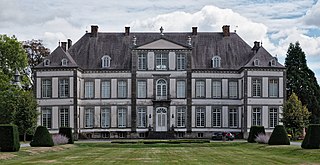 W
WAttre Castle is a former castle, now a country house or château, in Attre in the municipality of Brugelette, province of Hainaut, Wallonia, Belgium.
 W
WAulne Abbey was a Cistercian monastery located in Wallonia between Thuin and Landelies on the Sambre in the Bishopric of Liège in Belgium, now a Walloon Heritage Site.
 W
WThe belfry of Mons is one of the more recent among the belfries of Belgium and France. This belfry, classified in Belgium since 15 January 1936, belongs to the major cultural patrimony of Wallonia. and is classified as a World Heritage Site by UNESCO since 1 December 1999. It is the only one in Belgium that is constructed in baroque style. At a height of 87 meters, it dominates the city of Mons, which is constructed on a hill itself.
 W
WThe belfry of Namur, also called the Tour Saint-Jacques, is an historical building of the city of Namur, Belgium. The tower, constructed in 1388 as part of the city wall, became a belfry in 1746. It is one of the 56 belfries of Belgium and France classified in the world patrimony of the UNESCO.
 W
WThe belfry of Tournai, Belgium, is a freestanding bell tower of medieval origin, 72 metres in height with a 256-step stairway. This landmark building is one of a set of belfries of Belgium and France registered on the UNESCO World Heritage List.
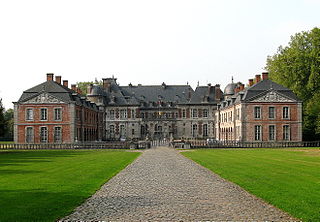 W
WThe Château de Belœil is a château situated in the municipality of Belœil in the province of Hainaut, Wallonia, Belgium. It serves as the main residence of the princes of Ligne. The château lies in the middle of a Baroque garden designed in 1664. The château and gardens can be visited during spring and summer.
 W
WBonne-Espérance Abbey was a Premonstratensian abbey that existed from 1130 to the end of the 18th century, located in Vellereille-les-Brayeux in the Walloon municipality of Estinnes, province of Hainaut, Diocese of Tournai, in present-day Belgium.
 W
WBouillon Castle is a medieval castle located in Wallonia in the town of Bouillon in the province of Luxembourg, Belgium.
 W
WThe Castle of Freÿr with its gardens in the style of Le Nôtre is located in Wallonia on the left bank of the Meuse, between Waulsort and Dinant. They form one of the most magnificent natural sites in Belgium. It has been classified as one of Wallonia's major heritage sites. It is often called a greatly reduced Versailles. Originally a Renaissance castle, it was extended in the 18th century and was once the residence of dukes and their royal guests. It has gardens including orange trees. The more than three-hundred-year-old orangeries are the oldest in the Low Countries.
 W
WThe Castle of Vêves occupies a rocky platform in Wallonia just outside the village of Celles, in the province of Namur, Belgium. It is classified as Major Heritage of Wallonia. According to tradition, the site has been occupied by castles since the time of Pippin of Herstal. In the later Middle Ages, the area fell under control of the Beaufort family, which oversaw the construction of a stronghold here in about 1230.
 W
WThe Château of Modave, also known as the Château des Comtes de Marchin is a château near the village of Modave in Liège Province, Wallonia, Belgium.
 W
WThe Château of Seneffe or Château de Seneffe is an 18th-century château located in the municipality of Seneffe in the province of Hainaut, Wallonia, Belgium. The château is property of the French Community of Belgium and serves as the "Centre de l'orfèvrerie de la communauté française" which displays a collection of antique silverware.
 W
WThe Church of St John the Evangelist in the city of Liège, Belgium, was founded as a collegiate church by Notker of Liège around 980, and consecrated in 987. It was the place of Notker's tomb. The church was suppressed in 1797 during the French Revolution, the building being confiscated and sold in 1798.
 W
WThe Church of St. Denis in Liège, Belgium, is a former fortified collegiate church, founded by Notker of Liège in 987 and first consecrated on 12 March 990. The tower was added around 1100. The church has since 1936 been registered as a listed building, and is currently listed as "exceptional heritage" of Wallonia.
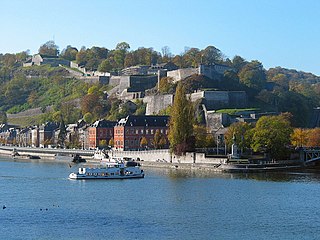 W
WThe Citadel or Castle of Namur is a fortress in the Walloon capital city of Namur, at the confluence of the Sambre and Meuse rivers. It is originally from the Roman era, but has been rebuilt several times. Its current form was designed by Menno van Coehoorn, and improved upon by Vauban after the siege of 1692. It has been classified as a Wallonia Major Heritage site. Its highest point sits at 190m.
 W
WThe Collegiate Church of St. Gertrude is a historical building in Nivelles, Walloon Brabant, Wallonia, Belgium, which was built in the 11th century.
 W
WThe Collegiate Church of St. Bartholomew is an historical building in Liège, Belgium. Founded outside the city walls, it was built in coal sandstone, starting in the late 11th century and lasting until the late 12th century. It underwent, like most ancient religious buildings, modifications through the centuries. Nevertheless, the Meuse Romanesque—Ottonian architecture character of its architecture remained deeply rooted. The 18th century saw the addition of two more aisles, the opening of a neoclassical portal in the walls of the westwork, and the French Baroque redecoration of the interior. The interior of the western section has recently been restored back to the original style.
 W
WThe Castle of Corroy-le-Château is a medieval castle in the village of Corroy-le-Château, near Gembloux, in the province of Namur, Wallonia, Belgium. Originally built between 1220 and 1230 by William of Brabant, the castle is one of the best-preserved medieval buildings in Belgium, with gigantic round towers and a moat.
 W
WThe Curtius Museum is a museum of archaeology and decorative arts, located on the bank of the Meuse River in Liège, classified as a Major Heritage of Wallonia.
 W
WDinant is a city and municipality of Wallonia located in the province of Namur, Belgium. On the shores of river Meuse, in the Ardennes, it lies 90 kilometres (56 mi) south-east of Brussels, 30 kilometres (19 mi) south-east of Charleroi and 30 kilometres (19 mi) south of the city of Namur. Dinant is situated 20 kilometres (12 mi) north of the border with France.
 W
WEnghien is a city and municipality of Wallonia located in the province of Hainaut, Belgium.
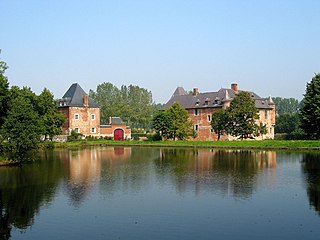 W
WFernelmont Castle is a fortified farmhouse or château-ferme in Noville-les-Bois in the municipality of Fernelmont, Wallonia, Belgium.
 W
WFloreffe Abbey is a former Premonstratensian monastery, the second of the order to be founded, situated in Wallonia on the Sambre at Floreffe, about 11 km southwest of Namur, Belgium.
 W
WThe Château de Franc-Waret is a château situated in Franc-Waret in the municipality of Fernelmont in the province of Namur, Wallonia, Belgium. A moat girdles the castle. The castle is adorned by French gardens and an English style garden sprawls over 120 hectares of the palace.
 W
WGrand-Hornu is an old industrial coal mining complex and company town in Hornu (Boussu), near Mons, in Belgium. It was built by Henri De Gorge between 1810 and 1830. It is a unique example of functional town-planning. Today it is owned by the province of Hainaut, which houses temporary exhibitions in the buildings. It is one of the four industrial sites which were listed by UNESCO as a World Heritage Site in 2012
 W
WHastière is a municipality of Wallonia located in the province of Namur, Belgium.
 W
WThe High Fens, which were declared a nature reserve in 1957, are an upland area, a plateau region in Liège Province, in the east of Belgium and adjoining parts of Germany, between the Ardennes and the Eifel highlands. The High Fens are the largest nature reserve or park in Belgium, with an area of 4,501.2 ha ; it lies within the German-Belgian natural park Hohes Venn-Eifel, in the Ardennes. Its highest point, at 694 metres (2,277 ft) above sea level, is the Signal de Botrange near Eupen, and also the highest point in Belgium. A tower 6 metres (20 ft) high was built here that reaches 700 metres (2,297 ft) above sea level. The reserve is a rich ecological endowment of Belgium covered with alpine sphagnum raised bogs both on the plateau and in the valley basin; the bogs, which are over 10,000 years old, with their unique subalpine flora, fauna and microclimate, are key to the conservation work of the park.
 W
WJehay Castle or Jehay-Bodegnée Castle is a castle situated in the municipality of Amay in Liège Province, Wallonia, Belgium.
 W
WThe Castle of Lavaux-Sainte-Anne is a castle located in Wallonia near Rochefort, Province of Namur in Belgium. In 1450, Jean II de Berlo commissioned the building of the castle.
 W
WThe lifts on the Canal du Centre are a series of four hydraulic boat lifts near the town of La Louvière in Belgium which are classified as a World Heritage Site by UNESCO. All four are located on the Canal du Centre in Belgium's historic sillon industriel industrial belt.
 W
WThe Lion's Mound is a large conical artificial hill located in Wallonia in the municipality of Braine-l'Alleud, Belgium. King William I of the Netherlands ordered its construction in 1820, and it was completed in 1826. It commemorates the location on the battlefield of Waterloo where a musket ball hit the shoulder of William II of the Netherlands and knocked him from his horse during the battle. It is also a memorial of the Battle of Quatre Bras, which had been fought two days earlier, on 16 June 1815.
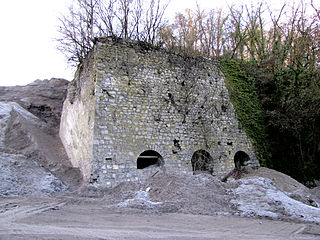 W
WThe Lyell Cave, formerly called Grande caverne d'Engihoul, is located near the ancienne commune of Éhein, municipality of Engis, Liège Province, Belgium. It is one of many caves investigated or discovered by Philippe-Charles Schmerling, in 1831; the cave is named for a later researcher, Sir Charles Lyell, who visited the cave in 1860.
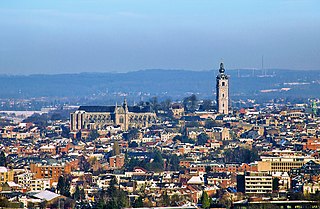 W
WMons is a city and municipality of Wallonia, and the capital of the province of Hainaut, Belgium.
 W
WMontaigle Castle is a ruined medieval castle in Falaën in the municipality of Onhaye, province of Namur, Wallonia.
 W
WThe Neolithic flint mines of Spiennes are among the largest and earliest Neolithic flint mines which survive in north-western Europe, located close to the Walloon village of Spiennes, southeast of Mons, Belgium. The mines were active during the mid and late Neolithic between 4,300 and 2,200 BC. Declared to be "remarkable for the diversity of technological solutions used for extraction" the site and its surroundings were inducted into the UNESCO's list of World Heritage Sites in 2000.
 W
WThe Ninglinspo is a stream in Belgium, tributary of the Amblève upstream from Remouchamps around Quarreux. The valley of Ninglinspo is classed as an outstanding heritage area of Wallonia. It runs between Vert-Buisson and Nonceveux. The Ninglinspo forms rapids around enormous blocks of quartzite, forming a series of pools with evocative names.
 W
WOrval Abbey is a Cistercian monastery founded in 1132 in the Gaume region of Belgium and is located in Villers-devant-Orval, part of Florenville, Wallonia in the province of Luxembourg. The abbey is well known for its history and spiritual life but also for its local production of the Trappist beer Orval and a specific cheese.
 W
WPoilvache Castle is a ruined medieval castle in the Walloon municipality of Yvoir in the province of Namur, Belgium, overlooking the village of Houx from a clifftop on the Meuse River.
 W
WThe Palace of the Prince-Bishops is a historic building situated on the Place Saint-Lambert in the centre of Liège, Belgium. It was the residence of former Prince-Bishops of Liège. It once faced the monumental Cathedral of Saint Lambert.
 W
WLe Rœulx Castle, also known as the Château des Princes de Croÿ, or "castle of the Princes de Croÿ", is a castle in the town of Le Rœulx in the province of Hainaut, Wallonia, Belgium.
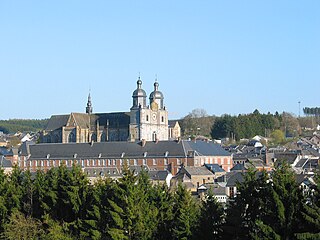 W
WSaint-Hubert is a city and municipality of Wallonia located in the province of Luxembourg, Belgium.
 W
WScladina, or Sclayn Cave, is an archaeological site located in Wallonia in the town of Sclayn, in the Andenne hills in Belgium, where excavations since 1978 have provided the material for an exhaustive collection of over thirteen thousand Mousterian stone artifacts and the fossilized remains of an especially ancient Neanderthal, called the Scladina child were discovered in 1993.
 W
WSoignies is a city and municipality of Wallonia located in the province of Hainaut, Belgium.
 W
WSombreffe Castle is a medieval castle in Sombreffe, province of Namur, Wallonia, Belgium.
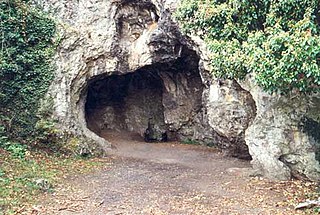 W
WSpy Cave is located in Wallonia near Spy in the municipality of Jemeppe-sur-Sambre, Namur Province, Belgium above the left bank of the Orneau River. Classified as a premier Heritage site of the Walloon Region, the location ranks among the most significant paleolithic sites in Europe. The cave consists of numerous small chambers and corridors.
 W
WSt Aubin's Cathedral, Namur, Wallonia, the only cathedral in Belgium in academic Late Baroque style. It was the only church built in the Low Countries as a cathedral after 1559, when most of the dioceses of the Netherlands were reorganized. It is classified as part of Wallonia's Major Heritage by the Walloon Region.
 W
WThe Tournai Cathedral, or Cathedral of Our Lady , is a Roman Catholic church, see of the Diocese of Tournai in Tournai, Belgium. It has been classified both as a Wallonia's major heritage since 1936 and as a World Heritage Site since 2000.
 W
WVillers Abbey is an ancient Cistercian abbey located in the town of Villers-la-Ville, in the Walloon Brabant province of Wallonia (Belgium), one piece of the Wallonia's Major Heritage. Founded in 1146, the abbey was abandoned in 1796. Most of the site has since fallen into ruins.
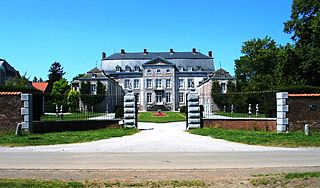 W
WWaleffe Castle is a castle in Belgium.
 W
WCastle of Warfusée is a castle located in the municipality Saint-Georges-sur-Meuse, Wallonia, near Liège, in Belgium. One of the loveliest castles in the area, Warfusée was completed in 1754 as a replacement for an earlier Renaissance structure. The castle served as a summer residence for Charles-Nicolas d'Oultremont, Prince-Bishop of Liège from 1763 to 1771, brother of the proprietor. To this day it still is the main residence of the Earls of d'Outremont. Access to the yard is via a gate under a tower with a steeple. The main building is flanked by two lower wings marking the boundaries of a vast yard. The rich interior has remained pretty much as it was at the time of building. The interior is truly exceptional; many talented artists were called upon: stuccos in the chapel, the superb entrance hall paved with marble with its beautiful staircase, the various drawing rooms with tapestry, the dining room with walls decorated with hand-painted engravings, and the huge library.
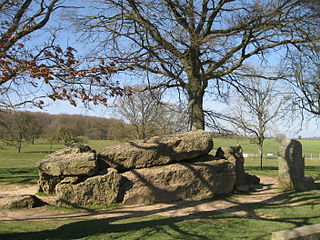 W
WThe Wéris megaliths are a group of megalithic monuments found near the village of Wéris, in the province of Luxembourg, in Belgium.